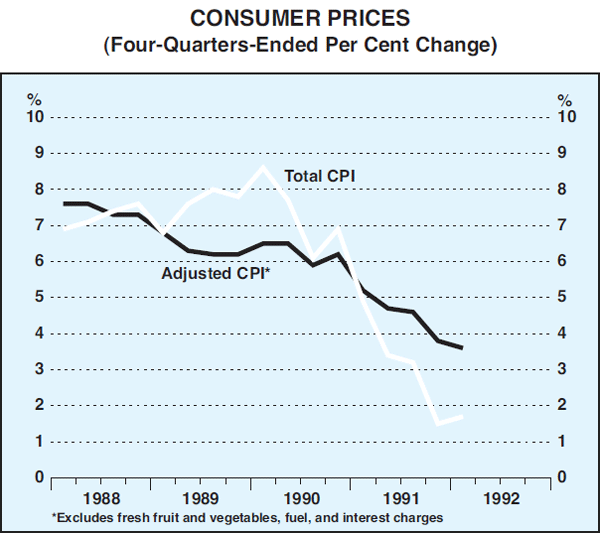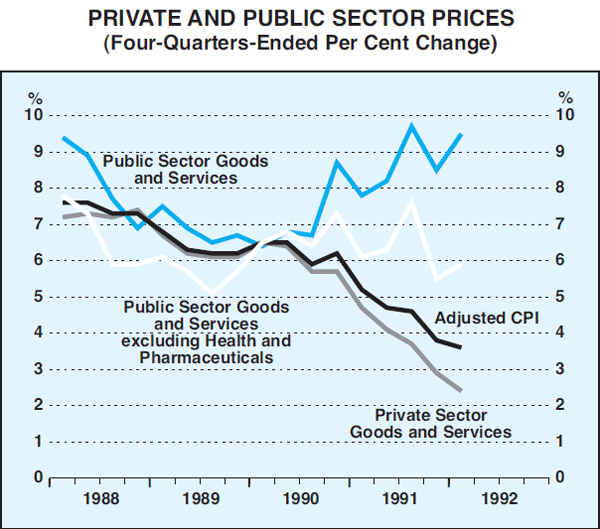Bulletin – May 1992 Recent Trends in Inflation
- Download 48KB
On any measure, inflation has slowed markedly in recent years. From the rates of 6–8 per cent typical in the last few years of the 1980s, growth of the consumer price index (CPI) slowed to 1.7 per cent in the four quarters to March this year; several other price measures are showing similar, or even lower, rates of increase. This article examines recent trends in inflation using a variety of measures, and focussing particularly on measures derived from the CPI. It suggests that, although special factors such as mortgage interest rate reductions have accentuated the slowing of growth in the CPI, inflation of private sector goods and services prices – which is where the effects of monetary policy would be expected to be seen most clearly – has slowed to a rate of around 2½–3 per cent.
The goods and services prices which make up the CPI can be split into three groups:
- a group of prices that are either (a) quite volatile (fresh fruit and vegetables and fuel, both of which are strongly influenced by temporary supply factors) or (b) are conceptually inappropriate for inclusion in a price index used for monetary policy analysis (mortgage interest charges and consumer credit charges, movements in which are usually the direct result of monetary policy actions, but whose effect on the CPI is in the opposite direction to the pressure applied to prices generally). These items together account for around 14 per cent of the CPI;
- a group of prices for goods and services which can be categorised as being predominantly determined by the public sector. In this group are public dwelling rents, local government rates and charges, prices paid for household fuel and light, postal and telephone services, motoring charges, urban transport fares, and the prices of health services, pharmaceuticals, education and child care. The prices of these items tend to respond primarily to changes in government policies, which are non-commercial in nature, and public enterprise pricing policies, which can often reflect government regulatory decisions. These items also account for around 14 per cent of the CPI; and
- prices of all other items. These can be broadly categorised as representing the less volatile prices of privately-provided goods and services; they account for 71 per cent of the CPI.
Boundaries between these categories are, of course, not precise. For example, some parts of the health services, and education and child care sub-groups are privately-provided, although it can be argued that their prices strongly reflect non-commercial public policy decisions. As well, the prices of many of the privately-provided goods and services can be influenced by other regulatory factors such as indirect taxes.
Graph 1 shows the aggregate impact on the CPI of price movements in the volatile items and interest charges included above in group (i). In aggregate, these items added to CPI growth in 1989 and 1990, but reduced the annual growth rates from the March quarter of 1991 onwards. To a large extent, this pattern reflected the tightening (from April 1988) and subsequent easing of monetary policy (from January 1990), although the impact was accentuated at various stages by big swings in fresh fruit and vegetable prices and fuel prices. Growth in an adjusted CPI, which excludes these items, has slowed to 3.6 per cent over the year to March, from the 6–8 per cent range which was typical over the previous three years.

This adjusted CPI can be further split between prices which are predominantly determined by the private or public sectors. Recent movements in these two sub-components are shown in Graph 2.

The rate of growth of public sector prices has been increasing over the past two years; they rose by 9½ per cent in the year to the March quarter, driven mainly by rapid rises in prices for health services. The strong growth of health prices was fairly broadly-based over this period, but was further boosted recently by the effect of the Medicare co-payment. This latter effect will be reversed in the June quarter CPI following the removal of the co-payment on 1 March. When health services and pharmaceuticals are excluded, the trend for public price rises has been relatively flat, at around 6–7 per cent in the past two years, though still higher than the rate for the CPI as a whole.
The remainder of the CPI, broadly reflecting private sector pricing decisions, rose by 2.4 per cent in the year to the March quarter. This measure of inflation has trended down consistently over the past two years.[1] While it has benefitted from some once-off effects, such as the decline in airfares due to deregulation of aviation, it appears that inflation of private sector goods and services prices can be characterised as around 2½ per cent, and certainly less than 3 per cent.
Within this group, private goods prices increased by 2.8 per cent over the year to the March quarter, while private services prices increased by 1.3 per cent. This represents a change from the usual pattern in previous years when services prices had tended to grow more quickly than goods prices. As service industries are typically labour-intensive, this slowing is probably associated with slower nominal wages growth. Growth in ordinary time earnings in the private sector on a four-quarter-ended basis has slowed from 6.9 per cent in the December quarter of 1990 to 3.8 per cent in the December quarter of 1991.
Additional measures of price and cost movements are presented in Table 1, and confirm the picture of a broadly-based decline in inflation. Consumer and producer prices, output and input prices, and nominal labour costs have all slowed during the past two years, and are rising at rates which are historically quite low.
| March 1990 |
March 1991 |
Latest Period |
|
|---|---|---|---|
| Consumer prices | |||
| Total CPI | 8.6 | 4.9 | 1.7 (Mar.) |
| Prices for privately-provided goods and services* | 6.5 | 4.7 | 2.4 (Mar.) |
| Private consumption deflator | 6.9 | 5.0 | 2.0 (Dec.) |
| Producer prices | |||
| Manufacturing output prices (excluding petroleum) | 5.6 | 3.2 | 0.8 (Feb.) |
| Manufacturing input prices (excluding petroleum) | 3.7 | −0.9 | 0.8 (Feb.) |
| House building materials prices | 7.1 | 4.7 | −0.7 (Feb.) |
| Other building materials prices | 7.8 | 4.8 | −0.1 (Feb.) |
| Broader measures | |||
| Domestic final demand deflator | 6.0 | 4.3 | 1.6 (Dec.) |
| GDP deflator | 5.0 | 2.7 | 0.9 (Dec.) |
| Gross non-farm product deflator | 5.5 | 3.8 | 0.7 (Dec.) |
| Nominal labour costs | |||
| Awards | 6.5 | 4.5 | 2.9 (Feb.) |
| Private sector ordinary time earnings | 6.6 | 7.5 | 3.8 (Nov.) |
| Average non-farm earnings (National Accounts) | 6.3 | 5.4 | 2.6 (Dec.) |
| * Total CPI less fresh fruit and vegetables, fuel, mortgage interest charges, consumer credit charges, public dwelling rents, local government rates and charges, household fuel and light, postal and telephone services, motoring charges, urban transport fares, health services, pharmaceuticals, and education and child care. | |||
Footnote
This measure of private sector inflation is similar to the Treasury's measure of ‘underlying’ inflation. The main differences are that the latter does not exclude motoring charges, but does exclude an additional four items (meat and seafoods, tobacco and alcohol, clothing, and holiday travel and accommodation), which exhibit seasonality and together account for 21 per cent of the CPI. Because these items have had slower than average price increases recently, the Treasury underlying rate is running slightly faster than the private sector rate defined in this article. [1]